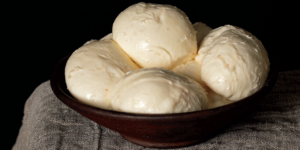How To Make Homemade Fresh Mozzarella
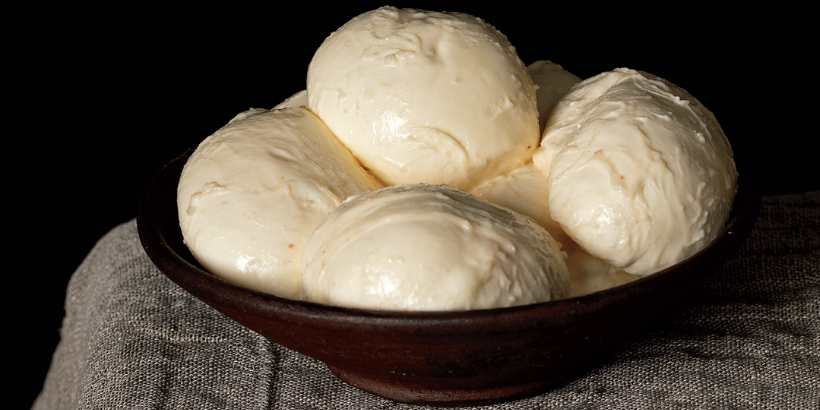
There is something so fun and rewarding about pulling out a gallon or two of milk and deciding to make some homemade mozzarella. It is super delicious: creamy, salty, all the best things when it comes to cheese.
Have faith that with a little practice, you can enter into the world of cheesemaking and make your own mozzarella!
The following is an excerpt from Milk Into Cheese by David Asher. It has been adapted for the web.
Photo Credit: ALIZA ELIAZAROV
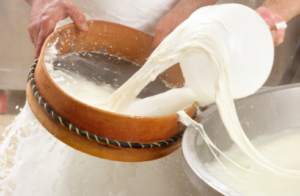 A first pasta filata, or spun-curd, cheese, mozzarella is made by melting curds that have been fermented to just the right degree so that they spin fibers when submerged in hot water. And it’s just one of dozens of different pasta filata cheeses made in Italy and around the world that are all extraordinary elaborations of this most manipulable form of milk.
A first pasta filata, or spun-curd, cheese, mozzarella is made by melting curds that have been fermented to just the right degree so that they spin fibers when submerged in hot water. And it’s just one of dozens of different pasta filata cheeses made in Italy and around the world that are all extraordinary elaborations of this most manipulable form of milk.
To prepare mozzarella, make a rennet cheese as usual from the freshest, least processed milk, but with a thermophilic starter. Cut the curd and stir lightly to firm, then leave it to ferment beneath warm whey until its curd spins fibers when submerged in very hot water. Test a small piece of curd for stretch every half hour or so while it is fermenting so that you don’t miss the pasta filata stretching window.
Once the curd begins to show signs of stretch you will want to quickly prepare for the mozzarella making
Bring water to a boil, and prepare the cold-water bath and light salt brine. When the cheese achieves its full stretch, ladle the hot water over the curd in a melting vat a couple of ladles-ful at a time, stirring the curd gently between additions, until it melts into a stretchy mass. Do not add too much hot water too quickly, as the curd can overcook and be difficult to handle.
Once it’s melted, gather together the curd with the help of a wooden spoon or paddle (steel sticks to melted curd) and lightly knead it to help work the melted cheese and develop its strength. Though the melting water is hot enough to burn, the curd should be just cool enough to touch and shape. Having a bowl of cold water handy to plunge your hands into helps with the high temperatures, as does using a wooden spoon to retrieve the curd from the hot water.
I’ll do my best to describe the method of mozzarella’s forming here.
To start the process, lift the curd slightly out of the water with a wooden spoon and pull a lump of melted cheese from the mass of curd with your left hand (switch everything around if you’re a leftie). Grab the curd with your right hand and pull it with your left one into a short length before folding it back onto itself accordion-like. Now stretch the curd in your left hand over the accordion with both hands to make a ball containing it all. Break this from the mass of curd between the thumb and first finger of your right hand with a very tight squeeze, while supporting it with the left. With your left hand, toss the mozzarella into the cold-water bath to cool and firm, before submerging it in the light salt brine to preserve.
It is best to work in a fluid fashion, keeping the curd in your hands so that you never have to retrieve the working end from the hot water in the melting vat. As you tear the mozzarella from the mass with your right hand, hold on to the torn end of the curd with that hand as the left hand takes the mozzarella and transfers it to the cold-water bath. This way, the working end of the curd is ready for the next tearing, and is transferred to your left hand before being pulled again into the next mozzarella by your right. As such the entire mass of curd can be spun into balls of mozzarella, one after the other after the other, until all the curd in the vat is used.
The name mozzarella derives from the Italian mozzare, to tear.
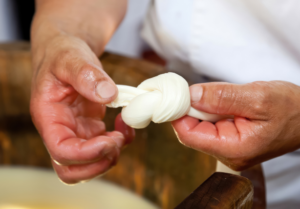 Other shapes that are made with the spinning dough in Italy include: nodini, little knots, a pulled length of curd tied into a knot before being torn; bocconcini, little mouthfuls, small balls of mozzarella; zizzona, mozzarella made into a massive breast; scamorza, mozzarella shaped into little gourds to be hung for smoking; and treccia, a three-strand braid. It’s even been known to be braided into elaborate shawls for festivals! Burrata and stracciatella are also made with a variation on this method, enriching the pasta filata cheese with cream (that’s stracciatella) before encasing it with stretched curd into a dumpling (burrata).
Other shapes that are made with the spinning dough in Italy include: nodini, little knots, a pulled length of curd tied into a knot before being torn; bocconcini, little mouthfuls, small balls of mozzarella; zizzona, mozzarella made into a massive breast; scamorza, mozzarella shaped into little gourds to be hung for smoking; and treccia, a three-strand braid. It’s even been known to be braided into elaborate shawls for festivals! Burrata and stracciatella are also made with a variation on this method, enriching the pasta filata cheese with cream (that’s stracciatella) before encasing it with stretched curd into a dumpling (burrata).
And a number of braided cheeses from Eastern Europe and the Middle East—often smoked and eaten in bars as beer cheese—are prepared by pulling the curd in hot water until it achieves a small fiber, then collecting the yarn-like curd and twisting it into a skein before smoking the salty cheese.
A most delicious and succulent fresh cheese, mozzarella can be prepared year-round with the milk of any animal.
However, this method, along with the other pasta filata cheeses, works best with buffalo or cow’s milk; if you’re using goat’s or sheep’s milk, the stretch and workability of the curd won’t be as developed, and it’s harder to judge when the curd is ready to melt. For an improved stretch, consider blending these milks 50–50 with cow, as is often done for caciocavallo. Buffalo is considered best for the mozzarella technique, but a cow’s milk mozzarella made using traditional methods, sweet and golden from its cream, will leave you questioning this reasoning (it may just be that water buffalo are more common in the swampy environs of Naples, the ancestral home of both mozzarella and pizza!). If you are using the milk of buffalo, though, be sure to handle the curds more lightly, barely stirring, if at all, and expect a roughly doubled yield—that’s the big benefit of buffalo!
This technique calls for making mozzarella slowly, with a mesophilic fermentation (using a mesophilic starter, like clabber) and a fermentation at lower temperatures, 30°C (86°F), developing its stretch within 6 to 8 hours. But a faster, more thermophilic mozzarella (made with a thermophilic starter, like yogurt, fermented at 40°C [105°F], and ready in about 3 hours total) can be made instead. The thermophilic mozzarella retains more sweetness due to the straight lactic acid fermentation, but the mesophilic mozza develops more flavor in its flesh from a fuller heterofermentation (there’s less lactose resulting when the more diversely fermented cheese reaches a pH of 5.3).
You decide what works for you. And any pasta filata style can be prepared with either approach.
Making Mozzarella
A pasta filata cheese • made with cow’s or buffalo milk • 6- to 8-hour make
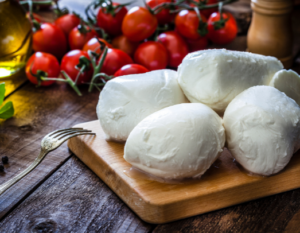
INGREDIENTS
- milk: 10 L
- starter: 100 ml clabber, kefir, or whey (1:100)
- rennet: regular dose calf rennet
- salt
Yield 1 kg mozzarella in brine (10:1)
TECHNIQUE
- Bring milk to cheese temperature, about 35°C (95°F).
- Add starter, mix in thoroughly.
- Add rennet, mix in thoroughly.
- Wait for clean break, 45 minutes to 1 hour.
- Cover the pot to keep in warmth.
- Cut curd to walnut size, 2.5 cm.
- Cut vertically; cut crosswise; cut horizontally or diagonally.
- Stir curds gently over 5 to 10 minutes.
- Ferment curds under whey at ambient temperature until acidity develops.
- Goal pH 5.3—stretch test spins.
- Perform teabag test every 30 minutes.
- Mozzarella usually takes 6 to 8 hours total to develop its stretch.
- If the temperature of the curds drops below 30°C (86°F), gently warm curds back up.
- Prepare for mozzarella stretching as curd shows first signs of stretching.
- Bring 5 L water to a boil (half as much water as milk).
- Prepare a 5 L cold-water bath.
- Prepare a light salt brine with 2 L cold water and 1 percent salt (brine should taste good!).
- Strain the curds from the whey.
- Pour almost-boiling water over curds until curds melt evenly.
- Add hot water slowly, stirring curds gently between additions.
- Add more hot water as needed, but do not overcook.
- Gently bring curds together into a single mass under the water.
- Shape curds into mozzarella.
- Stretch a handful of curd from the mass into a 15 cm rope.
- Fold rope into an accordion (or roll into a stout pinwheel).
- Stretch top part of the cheese over the accordion to make a ball.
- Tear mozzarella off the mass between thumb and forefinger.
- Plunge mozzarella into cold-water bath.
- Leave in water until cool.
- Transfer mozzarella to light salt brine and refrigerate to preserve.
Recommended Reads
Recent Articles
Mulberries have a special power of unlocking memories. Catching a whiff of a pie in the oven or taking that first delicious bite will transport you back to not only the first time you had mulberries, but each and every time. These sweet berries very well might be in your own backyard, your neighbor’s yard,…
Read MoreThere is something so fun and rewarding about pulling out a gallon or two of milk and deciding to make some homemade mozzarella. It is super delicious: creamy, salty, all the best things when it comes to cheese. Have faith that with a little practice, you can enter into the world of cheesemaking and make…
Read MoreMushrooms: they’re versatile, they’re delicious, and they’re extremely simple to grow in your yard or garden. We have a mushroom growing method that’s so simple, you have no excuse not to try it out. All you need is a log or tree stump, some mushroom starter, and a couple of basic tools. And you will…
Read MoreWhen Jereme was in North Carolina for the 2016 Mother Earth News Fair in Asheville, he picked up a local honey made from summer wildflowers. Why? He was inspired after visiting Fox Hill and sampling their Special Reserve Mead, which has hints of ginger and a unique blend of buckwheat honey and some lighter varietals.…
Read MoreAll hail the joyful juneberry! While these rich and sweet berries taste wonderful when they’re fresh, you can also preserve them, use them as a substitute for blueberries in dessert recipes, and used to make wine, beer or cider. To create these delicious dishes, you first need to find and harvest juneberries. Get ready to set…
Read More





